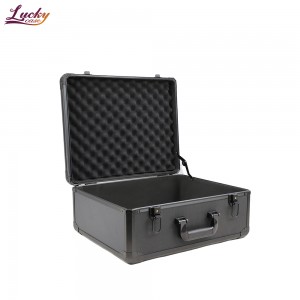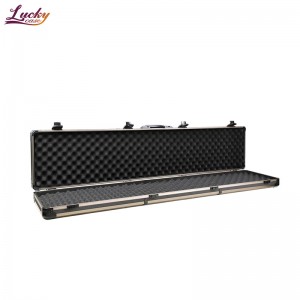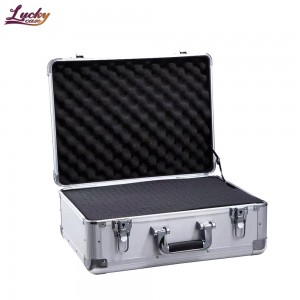
Aluminum Tool Case
Custom Aluminum Case Tool Case with EVA Foam Supplier
♠ Product Description
Durable and Protective Construction
This custom aluminum case is built with high-quality, sturdy materials to withstand daily wear and tear. Its rigid aluminum frame provides superior impact resistance, protecting valuable tools and equipment from damage. Combined with reinforced corners and reliable latches, it ensures your contents remain safe during transport, storage, or industrial use, giving peace of mind for professional applications.
EVA Foam Inserts for Organization
Equipped with precision-cut EVA foam inserts, this case offers customized protection for every tool or instrument. The foam cushions items against shocks, prevents movement, and reduces the risk of scratches or damage. It allows for efficient organization, making it easy to access equipment quickly, saving time and improving workflow for professionals in any field.
Versatile and Professional Design
Designed for both functionality and appearance, this aluminum case suits a variety of industries. Its sleek, professional look complements business or field environments, while its lightweight yet sturdy design ensures portability. Ideal for tools, electronics, and delicate instruments, the case combines practicality, durability, and style, making it a reliable choice for professionals who demand both performance and presentation.
♠ Product Attributes
| Product Name: | Aluminum Tool Case |
| Dimension: | We provide comprehensive and customizable services to meet your diverse needs |
| Color: | Silver / Black / Customized |
| Materials: | Aluminum + ABS panel + Hardware + EVA foam |
| Logo: | Available for silk-screen logo / emboss logo / laser logo |
| MOQ: | 100pcs( Negotiable ) |
| Sample Time: | 7-15 days |
| Production Time: | 4 weeks after confirmed the order |
♠ Product Details

Hinge
The hinge connects the case lid to the body, allowing smooth and secure opening and closing. A well-constructed hinge ensures stability and durability, preventing misalignment or breakage over time. It supports repeated use while maintaining the case’s structural integrity, ensuring that the lid opens fully for easy access and closes tightly to protect the contents from dust, debris, and accidental spillage.

Handle
The handle provides a secure and comfortable grip, allowing easy portability of the aluminum case. Designed to support the case’s full weight, it reduces strain during transport. Its sturdy construction ensures reliability even when carrying heavy tools or equipment, while ergonomic design enhances user comfort, making it convenient for professionals who frequently move their cases between job sites or storage areas.

EVA Foam
EVA foam provides cushioned support for tools and equipment inside the case. Its shock-absorbing properties protect delicate items from impact, scratches, and shifting during transport. Foam inserts can be customized to fit specific tools or instruments, improving organization and accessibility. By keeping items securely in place, EVA foam enhances safety, efficiency, and overall user convenience in professional applications.

Corner Protectors
Corner protectors reinforce the aluminum case at its most vulnerable points, preventing dents, cracks, and structural damage from impacts or drops. They absorb shocks and distribute force away from the case edges, extending the case’s lifespan. These protectors also contribute to a professional, rugged appearance, making the case suitable for both industrial and field environments where durability is essential.
♠ Production Process
1.Cutting Board
Cut the aluminum alloy sheet into the required size and shape. This requires the use of high-precision cutting equipment to ensure that the cut sheet is accurate in size and consistent in shape.
2.Cutting Aluminum
In this step, aluminum profiles (such as parts for connection and support) are cut into appropriate lengths and shapes. This also requires high-precision cutting equipment to ensure the accuracy of the size.
3.Punching
The cut aluminum alloy sheet is punched into various parts of the aluminum case, such as the case body, cover plate, tray, etc. through punching machinery. This step requires strict operation control to ensure that the shape and size of the parts meet the requirements.
4.Assembly
In this step, the punched parts are assembled to form the preliminary structure of the aluminum case. This may require the use of welding, bolts, nuts and other connection methods for fixing.
5.Rivet
Riveting is a common connection method in the assembly process of aluminum cases. The parts are firmly connected together by rivets to ensure the strength and stability of the aluminum case.
6.Cut Out Model
Additional cutting or trimming is performed on the assembled aluminum case to meet specific design or functional requirements.
7.Glue
Use adhesive to firmly bond specific parts or components together. This usually involves the reinforcement of the internal structure of the aluminum case and the filling of gaps. For example, it may be necessary to glue the lining of EVA foam or other soft materials to the inner wall of the aluminum case through adhesive to improve the sound insulation, shock absorption and protection performance of the case. This step requires precise operation to ensure that the bonded parts are firm and the appearance is neat.
8.Lining Process
After the bonding step is completed, the lining treatment stage is entered. The main task of this step is to handle and sort out the lining material that has been pasted to the inside of the aluminum case. Remove excess adhesive, smooth the surface of the lining, check for problems such as bubbles or wrinkles, and ensure that the lining fits tightly with the inside of the aluminum case. After the lining treatment is completed, the interior of the aluminum case will present a neat, beautiful and fully functional appearance.
9.QC
Quality control inspections are required at multiple stages in the production process. This includes appearance inspection, size inspection, sealing performance test, etc. The purpose of QC is to ensure that each production step meets the design requirements and quality standards.
10.Package
After the aluminum case is manufactured, it needs to be properly packaged to protect the product from damage. Packaging materials include foam, cartons, etc.
11.Shipment
The last step is to transport the aluminum case to the customer or end user. This involves arrangements in logistics, transportation, and delivery.

The production process of this aluminum tool case can refer to the above pictures.
For more details about this aluminum tool case, please contact us!




























